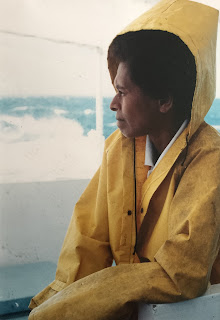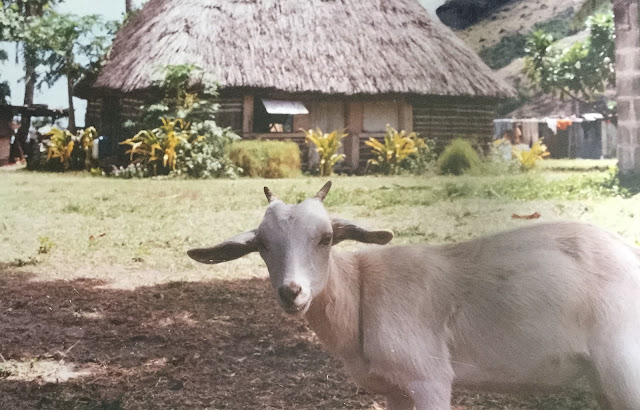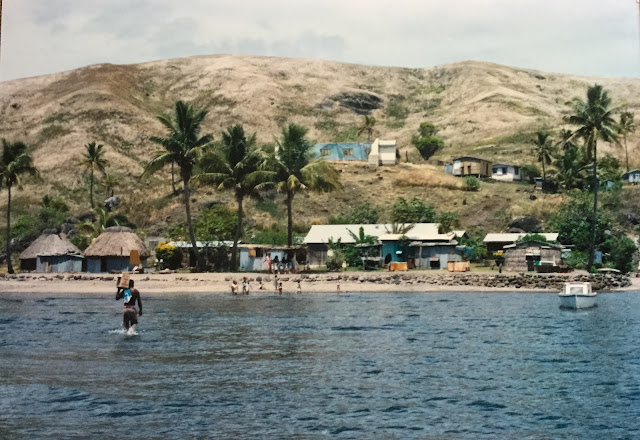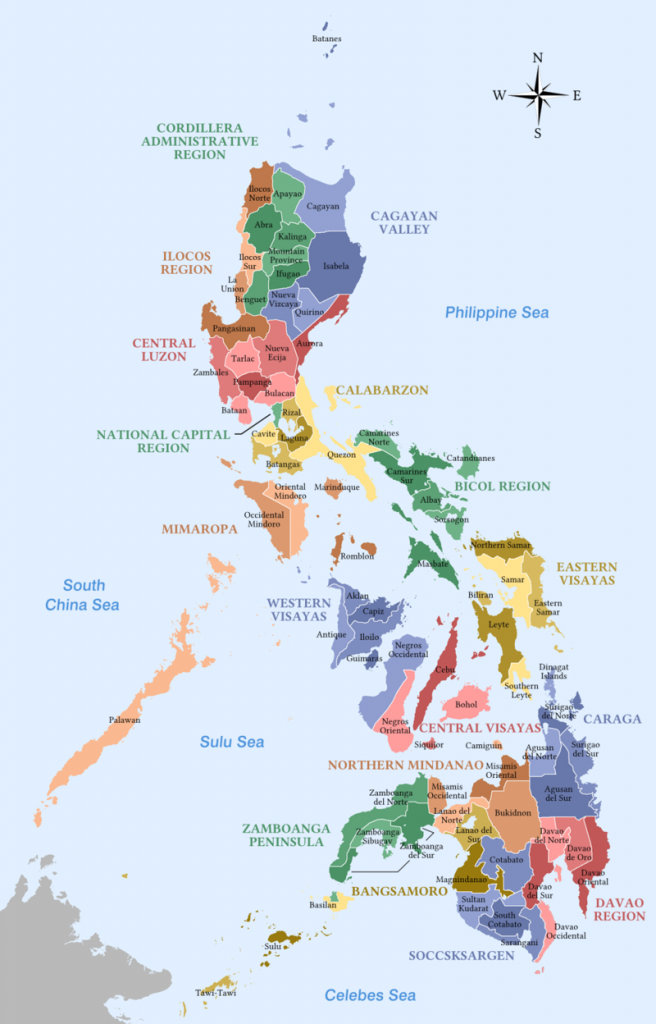All Global Research articles can be read in 51 languages by activating the Translate Website button below the author’s name (desktop version)
To receive Global Research’s Daily Newsletter (selected articles), click here.
Follow us on Instagram and Twitter and subscribe to our Telegram Channel. Feel free to repost and share widely Global Research articles.
***
Two coups had overturned a left-leaning government in Fiji. Only a month after nationwide elections, a fundamentalist general had taken charge. A year later I wanted to talk with the Christian Socialist doctor and labor leader who was Prime Minister so briefly in the spring of 1987.
I also wanted to relax, to find out what paradise was like, to shed my shoes and sit at the ocean’s edge just watching the tide roll in.
We were just a few miles south of Bligh Water, riding the whitecaps toward a South Pacific island. More than two hundred years ago Captain William Bligh and 18 of his men, cast adrift by the mutineers of the HMS Bounty, covered the same waters. But in 1789 the men on the longboat pulled oars, and the Fijians pursuing them were angry cannibals In 1988 cruise ships and market boats brought most people to the islands, and the welcome was far more encouraging.
Bligh’s group escaped to Timor, an island near Indonesia, and never had the luxury to spend a few weeks on the lush islands that many people often imagine as paradise. Fiji’s native Melanesians haven’t eaten any visitors for more than a century. On the contrary, they’ve become so “pacific” in their approach to life that even two military coups hadn’t led to bloodshed.
Even before that, Fiji wasn’t the most popular or accessible vacation spot on the globe. From New England it took 18 hours by plane, not counting airport madness. And when you landed at the tiny international airport in Nadi (pronounced Nandi), you had really just begun your trip. But that was part of the charm of going to the other end of the earth. Everything broke ingrained patterns and reopened jaded eyes.
I’d made the journey for both pleasure and politics. In 1987, I left the US on a one-way ticket and became a West German resident. Looking back, I view it as an expatriate aspiration, harbored for years, and then sparked by the second election of Ronald Reagan. Jutta, my flat mate and lover in Munich, was well-traveled, had visited Fiji several times, and understood the culture.
Politically, I was curious about the roots of the two coups that had overturned a left-leaning government. Just a month after nationwide elections, Sitiveni Rabuka, a fundamentalist general, had taken charge. “I was chosen by the Almighty,” he claimed. A year later I wanted to talk with Timoci Bavadra, the Christian Socialist doctor and labor leader who was Prime Minister briefly in the spring of 1987. I also wanted to relax, to find out what paradise was like, to shed my shoes and sit at the ocean’s edge just watching the tide roll in.
Fiji is a sprawling collection of 322 islands about 1,400 miles east of Australia, perched at the edge of the Indo-Australian plate. Many are sunken volcanic remnants of a long lost continent. Over 100 are inhabited by a mixture of Melanesians, Polynesians and East Indians, plus a smattering of Chinese, Micronesian and European expatriates.
Because the country spent 100 years as a British colony, most people spoke English fluently, though with a distinct accent. Their mother tongues, however, were liable to be Fijian, Hindi, or one of several Pacific variations. Walking through the huge open air market in Suva, the national capital on Viti Levu, I heard a rich linguistic blend as people hawked produce grown in the village garden plots.
Most Fijian natives had their own small piece of paradise — land. They could grow enough food to be almost self-sufficient. Only a few staples like sugar, tea, and flour, along with some canned and junk food, were imported from the capital. But Indians, who outnumbered Fijians on the two biggest islands, weren’t permitted to buy native-owned land. Over the years since immigrating, however, they had come to virtually monopolize the middle levels of business.
When you wanted to take a taxi or go browsing in a city shop, you’d almost always deal with an Indian. But if you wanted some papaya or an island adventure, you started by meeting one of the dark-skinned, curly-headed native Fijians.
Getting into the country, it turned out, was the simple part. Finding the “real” Fiji, away from its Europeanized cities, required an invitation.

Adi Sayaba, our ticket to ride, was an island rarity, a clever business woman who had turned her clan’s compound on Waya island into a miniature resort. One of her bures (houses) was equipped with a gas-powered stove, refrigerator and bed space for up to six people. Her outhouse sported the only flush toilet on the island. There was no electricity, however, and the strictly rationed village water ran for only an hour or two each day.
We rendezvoused with Adi in Lautoka, a port city on the dry western coast of Viti Levu. At the wharf we waited for hours as she tried to arrange our voyage, haggling with captains for seats on a motor-powered boat. The winds were too stiff that day, so our ship never sailed.
But Adi (the name is actually a title for female chiefs) had an uncle, she explained, who captained a modern launch used by divers. We spent the night at his house, watching videos with the extended family. Early the next morning we made it, finally, onto the water.
As the sea splashed over the deck, captain Elisa headed for the Yasawas, a chain of 16 islands that begins about two hours from Lautoka. Soon we could see Waya, its mass of rock jutting into the clear blue sky, its deep, clear water and white beaches beckoning. When we were in sight of Yalobi, Adi’s village, a corrugated tin boat sped out to ferry us ashore.
“You’ll have to visit the chief,” Adi reminded us. “Do you have the kava?”
We did. Jutta was well acquainted with the protocols of island life. In the Suva market, we purchased a batch of the pepper plant root that, when pounded into dust and mixed with water, becomes Fiji’s national drink.
The chief wasn’t at home on the day we arrived. When he was ready to receive us, Adi advised, he’d let us know.

Each island and village in Fiji had a chief, a hereditary leader who exerted a strong traditional influence. Although the country had a constitutional government the great Council of Chiefs also played a prominent and powerful watchdog role.
We met Waya’s chief in his ornate thatched bure near Yalobi’s white sand beach. Palm trees lined the path to his door. Inside the walls and floors were covered with woven mats. Round wooden beams stretched the length of the building under a high peaked roof.
“This house is hurricane proof,” the chief announced proudly after we removed our sandals and took our places on the floor.
Expressing our admiration, we pushed our sevusevu (offering) forward and waited for the kava drinking to begin. At the head of the circle, lit by Coleman lanterns, the official mixer prepared the ceremonial drink in a hand-carved wooden bowl.
Known as yagona or grog, this traditional non-alcoholic beverage is actually a tranquilizing drug that numbs the tongue, and unless abused, helps to focus the attention. Sharing the drug is the most honored feature of Fiji’s formal life, a ceremony and social event that sometimes goes on well into the night.
First, the mixer offered a prayer of thanks and welcome. Then the kava was served in polished coconut shells. Tradition determined the order of service and participatory ritual. As I accepted my bowl, I clapped my hands once; everyone else clapped three times in response. I downed the slightly muddy-tasting liquid in one gulp. Afterward, everyone gave another three claps.
With each round and each drink, we repeated the ritual. In between, we talked about our trip, the old days on the island, and Adi’s father, Timoci. “The old man with the young spirit” had died a year before. He had been a warm and inspiring presence on Waya, a wise man, a teacher and a World War II hero of the Solomon Islands.
Even the chief, who was only “top man” because Timoci hadn’t wanted the job, missed the village leader.

The days melted past, the hot sun making me lazy and relaxed. There was nothing to do, really, except just be — or meet people, watch children play or watch women make mats and crafts for visiting tourists.
The only downside was this also opened much too much time to think about the end of my relationship with Jutta. The night before boarding our flight she had dropped the news: She wanted to break up. But she also wanted me to make the trip anyway. Once we arrived in Fiji she was a fine companion, but not much interested in discussing the last year. In the end, I came to think it may have been the right move. Just being there helped me to reflect and process what was happening between us.
On most weekdays, a huge Blue Lagoon cruise ship pulled into the bay at midday, disgorging passengers onto the beach. Villagers lined up their displays on the sand — shell and black coral jewelry, woven bags and gorgeous shells found along the coral reefs. Tourists browsed, spent some money and sampled the warm water.
Later the men came down from their hillside tetes (gardens) and families ate, stretching out afterward for post-dinner naps.
For foreigners, getting to know people could be difficult. Most islanders had little interest in the outside world. There were no shops or cafés, no nightlife except at the divers’ compound down the beach. But with a story or game I could break the ice and get a glimpse of daily life.
By accident, I also stumbled onto a way to start a real dialogue. My deck of Rider-Waite Tarot cards and dog-eared divination book created a doorway to intimacy. Laying out the cards, sometimes during kava ceremonies, I would merely describe what the pictures told me. Then I’d ask what the person who had shuffled was thinking about.
Without the slightest hesitation, people would open up about their marriage plans, worries about the future, struggles with a village “black magician,” or hopes for a good fishing catch. Thinking visually and dropping inhibitions, they would react viscerally to the imagery of the cards.
During tarot evenings, I learned about the foreign developers wrangling to establish a resort on a small nearby island owned by some Waya villagers. People told me their fears — of punishment for breaking a teenage beer-drinking taboo, or rivalries for a good building plot — and hopes for a resort job or a good crop.
Before I realized it, two weeks had passed. It was time to return to the mainland.
*
Reaching Dr. Bavadra proved complicated. Even with Adi’s contacts and an introduction from Captain Elisa, a relative, it took weeks to make the connection. Even out of power, the head of the Labor-Indian Coalition Party was busy man.
Meanwhile, we had a friend in Suva, Larry, who was more than willing to be our host. A part-European playwright, he worked at the University of the South Pacific and had a comfortable house near the sea.
Traveling without contacts can be trying, even in the best of circumstances. It’s not just the cost; in Fiji, hotel prices ranged then from $10 to $150, food was cheap and abundant. But without friends it could be hard to get off the well-trodden tourist path. Usually, I made travel contacts in advance through Servas, an international network of hosts and travelers. In this case, Larry invited us, eager to share thoughts and show us his new play.
The Fiji Arts Club was one of the few creative outlets for Suva’s intelligentsia. Since turning 19, Larry had been a central force, directing both foreign and native-written productions. This season’s play, Just another Day, was his first stab at directing his own work.
The play was a slice of local life. It was set in an average urban living room where a Fijian extended family shared tea, wisecracks and gossip. The mother, Margaret, smoked incessantly as she scolded the lazy boys and girls, gabbed with pregnant friends or argued with her husband.
A portrait of good-natured resignation and passivity, it should have been sad, but the ironic humor managed to keep it light. And the native cast played it with rough-edged verve and authenticity. Like Larry, some of them came from families much the same.
Larry and his educated friends were more aware of the country’s political turmoil than the Waya islanders. We spent many evenings speculating about Rabuka’s next moves. The most obvious effects of the coups were higher prices and unemployment.
The atmosphere was damaging to relations between ethnic Fijians and Indians. Relegated to second class status by the traditional Chiefs and the military, non-Fijians were losing faith in the future. Fijians were divided between defenders of native power and advocates of some kind of reform.
After 17 years of rule by the Alliance, a conservative party controlled by the chiefs, a new coalition had won a fair election. Indians joined forces with labor unions and urban intellectuals, won a parliamentary majority, and put Timoci Bavadra in charge. He was Fijian, but most of his support was Indian. Fear of their future dominance was a handy excuse to overreact.
One month later, Rabuka closed parliament at gunpoint and brought the old administration back. Newspapers were closed for several days, and troops kept the lid on demonstrators while Rabuka worked out a game plan with the chiefs. Negotiations between the Alliance and the Coalition eventually produced an apparent compromise. But Mara really wanted to rewrite the constitution to ensure a perpetual Fijian majority. On Sept. 25, about a month before I arrived, Rabuka led his second coup.
Australians and New Zealanders were incensed at the military takeover, as well as Rabuka’s manipulation of racial tensions and religious beliefs. He had weakened the press and expanded the military, and was trying to revamp the constitution. “The real intent,” charged Bavadra, “is to sanction the military dictatorship we now have.” He called the proposed constitutional overhaul “feudalistic, authoritarian and racist.”
By 1988, the number one song in Australia was a send-up of Susanne Vega’s hit about domestic abuse, “Luca,” called “My Name is Rabuka.” With gunfire in the background the dictator sang about his coups and warned, “You just don’t argue anymore.”
*
In Suva, I spoke with V. J. Naidu, a university professor who was active in the nuclear-free zone movement. Hopes for an anti-nuclear shift in Fiji’s foreign policy — under consideration by Bavadra’s government — had evaporated. “Parliament is ineffective, and there is no separation of powers,” he added. Yet Naidu could see a silver lining.
Despite the manipulation of race, there was actually little hatred between ethnic groups, he claimed. A new consciousness was emerging, and the economic problems intensified by the coups had spurred more skepticism.
Most of the Indian citizens I met were not so optimistic. They often talked about emigrating to Australia, and about their second class citizenship in an inflationary economy. More than 5,000 Indians initially left the country after Rabuka seized power, many of them skilled professionals.
Unemployment was over 10 percent. The tourist sector was the hardest hit. Only a dramatic increase in military recruitment was keeping the situation from becoming a full-blown crisis. Criticism was permitted — up to a point. But public discourse was muted by a cowed media and a generalized fear that tolerance had its limits.
In a review of Rabuka’s official biography, pointedly titled No Other Way, Professor Som Prakash noted that the coups ultimately produced the results they were designed to prevent: breaking the Commonwealth tie with Britain and opening the country to foreign infiltration.
“It is the Rabuka-backed government,” Prakash wrote, “which brought about the establishment of the Israeli embassy in Fiji and the strengthening of French connections. And this was an invitation to the Libyans, Palestinians and others to destabilize Fiji further. All but the most gullible reader will see that the bulk of Rabuka’s actions were based on some farfetched, often self-fulfilling prophecies with an ironic twist: what Rabuka claims he fears others might do, he ends up doing himself.” In many ways, he was following the dictator’s playbook, exploiting divisions and using classic Fascist techniques.
In Fiji, irony wasn’t hard to find. By breaking relations with Britain and souring ties with Australia and New Zealand, for instance, the coup-makers had created an opening for the Japanese and later others. One of the first Japanese acquisitions was the Pacific Harbor resort, one of the country’s most exclusive. By the early 21st century, India turned out to be a more acquisitive foreign investor, with China not far behind.
In the long run, preserving the exclusive land rights of Fijians, along with a Fijian lock of state power, turned out to be a very limited victory.
*
Back in Lautoka, just a day before leaving, I reached Bavadra’s wife Kuini (pronounced Queenie) on the phone. They might have time to see us that night if we wanted to take a taxi to Viseisei village. Luckily, it wasn’t Sunday, so Rabuka’s Sabbath ban on transportation couldn’t prevent the meeting.
Since Bavadra was also a chief, we brought an offering, some German tea. Doc Bavadra wasn’t home when we first arrived, but Kuini was friendly, articulate, and ready to begin. The house decor mixed European and Fijian influences; there were easy chairs and modern coffee tables, piled high with international magazines and newspapers, as well as traditional mats and an open space for kava ceremonies. The young men of the household, Bavadra’s disciples and bodyguards, watched us quietly as I asked my questions.
The two coups, Kuini explained, had actually been planned by former Prime Minister Ratu Mara in order to cover up years of graft. Rabuka was a front man; the real power had not changed hands.
Doc Bavadra joined us and agreed. Ratu Mara — full name Ratu Sir Kamisese Mara, Prime Minister since Independence in 1970 — had orchestrated racial tensions, approved plans for the takeover in advance, and provided help in the subsequent “neutralization” operation, he said. Like other autocrats, he didn’t want to surrender power.
Some charges couldn’t be verified, like rumors that US diplomats, worried about the independent drift in Fiji’s foreign policy, had given a silent nod. Or that American forces may have participated. But interviews with Fijians and others close to the previous and current regimes did verify that Mara’s Alliance Party was integral to the May 1987 overthrow. At least one member of Mara’s immediate family was directly involved. Yet Mara insisted publicly that he was surprised and dismayed, and only “reluctantly” returned to his old post at Rabuka’s request.
In reality, divisions had been stirred up between the Taukei (ethnic Fijian landowners and members of chiefly clans) and the Indian community. Firebombings of Indian businesses by Alliance Party supporters were claimed to be Taukei attacks. Meanwhile, the new government’s appointment of Indians to some key positions was vilified as the first stage of an Indian takeover, supposedly leading to the loss of exclusive Fijian land rights and eventual Soviet infiltration. Until the Coalition won, the major races had co-existed better than might have been expected.
“Traditional customs and democracy should be kept separate,” said Bavadra, “but the chiefs say people should follow their lead. Chiefs have to make a choice — stay in the villages or get into elections and play the game there under the rules that apply to everybody. Right now they expect to be treated differently than the rest.”
The talk eventually turned to hopes for the future. Both Doc and Kuini were confident that a majority of people would ultimately reject what they viewed as a “form of apartheid.” Kuini, herself a Fijian member of a chiefly family, rejected the notion of “special status” for Fijians as “an insult, which assumes that we are inferior and need a special status to compete.”
People were learning the truth, they believed. Traditional Taukei leaders and Methodists, once behind the coup-makers, were beginning to reconsider. If a referendum or new elections were permitted, the Coalition might gain a foothold in the government.
When we met, one reason for their optimism was the recent conversion of an old enemy, Ratu Meli, an ardent Taukei who was “converted through prayer meetings and confessed that he made a big mistake,” according to Kuini. “He sees that calling for Fijian supremacy was wrong, and knows he was used.” As a result, he signed a statement that revealed the true story of the coup, an action that angered other Taukei leaders.
Fijians believe in the power of such conversions. It was conversion to Christianity that led Fijians to give up cannibalism. Abandoning that grisly tradition saved the country from invasion and set the stage for Fiji’s cession to Britain. The worst impacts of being a Crown colony were also avoided, and in 1970 the country, still culturally intact, regained its independence. But that led to another, perhaps even deeper transition. Democracy was in its infancy, and the forces of tradition remained powerful.
“If you study the Fijian way of life,” said Doc Bavadra, “you see it is very democratic, based on reciprocity and consensus.” He believed in the possibility of a return to full democracy, a reduction of chiefly influence and improved relations between the races, without a loss of traditional Fijian land rights.
He was mostly correct. At least 90 percent of all land is still owned and controlled by native Fijians. Indians can lease plots for up to 30 years. But they still can’t own the land on which they farm or build their homes. It’s no surprise that many of them continue to feel insecure or ultimately decide to leave.
“I look at the people as one,” Bavadra nevertheless said when we met in 1988. “I don’t see them in terms of race. But the ones who need the most service are the underprivileged across race. There are classes here.”
Bavadra died in November 1989, only a year after we met. By 1992 the country had returned to democratic elections and a constitution-based government. Rabuka remained a powerful political force, in and out of legal office, for the next 30 years. At 74, he was just re-elected Prime Minister in 2022.
*
Fiji was an easy place to fall in love with. Despite the political turmoil and my relationship problems, I rarely felt as comfortable away from Vermont. Fiji has almost the same land area and only 300,000 more inhabitants than the Green Mountain State. It was intimate, open, polite and not overdeveloped. Aside from the mosquitoes, it was almost idyllic.
That can change, of course, but when I was there no one put Fiji at the top of their “to do” list for rapid exploitation, not even the Japanese. And Fijians didn’t seem eager to be modern anyway. On Waya island I sometimes heard gossip about gold. But no one seemed to care much if it was extracted. They mainly just liked the idea that it might be there. Today, by the way, Waya hosts at least four full-service resorts.
And when I worried about being detained at the airport as a result of meeting with Bavadra, a New Zealand expatriate told me not to worry. They had no computers then to put my name in, and were too pacific to be first-rate oppressors. That may be as close to a modern definition of paradise as you can get.
*
Note to readers: Please click the share buttons above. Follow us on Instagram and Twitter and subscribe to our Telegram Channel. Feel free to repost and share widely Global Research articles.
This article was originally published on the author’s blog site, Greg Guma / For Preservation & Change.
All images in this article are from the author

























